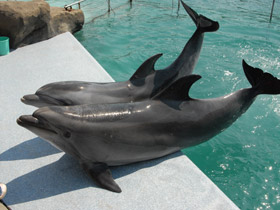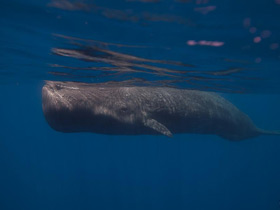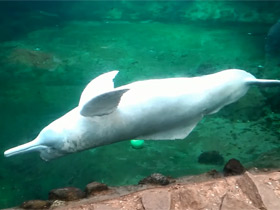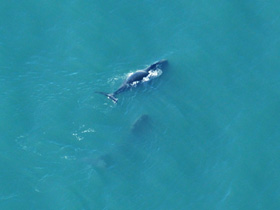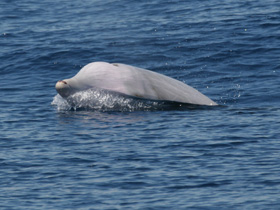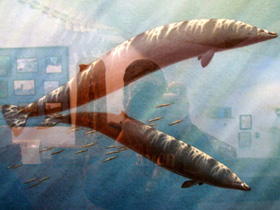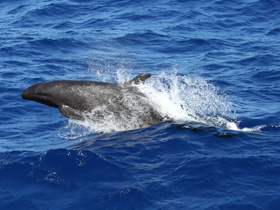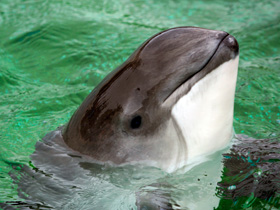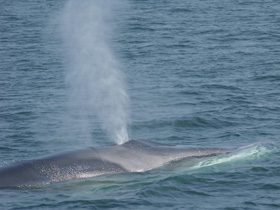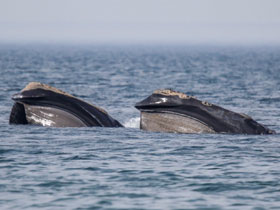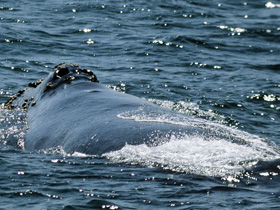Систематика Китообразных
Order Cetaceans Cetacea
The Cetaceans are exclusively adapted to aquatic life and can not survive on land. They evolved from four-limbed tetrapods, and lost their hind limbs (they have only internal rudiments of the hind limbs and pelvic girdle that are not attached to the rest of the skeleton). Their bodies acquired streamlined shape, front limbs modified into flippers; the tails flattened laterally and developed horizontal flukes at the tip. The teeth lost structures typical for other mammals and completely disappeared, or became numerous and peglike (which is functional in terms of holding prey). Their bodies are almost hairless; thick subcutaneous layer of fat and oil (blubber) serves as an insulation to protect them from hypothermia. The Cetaceans (toothed whales) use echolocation for navigating. Cetaceans produce ultra-high-frequency sounds (ultrasounds) and can perceive ultrasounds reflected back from various objects; that is how they are able to detect the distance from the object, as well as its shape and density. Their nostrils are located on the top of the head, forming the blowhole. Traditionally, the Cetaceans were referred to the order of Artiodactyla. Their ancestors were terrestrial omnivorous mammals that were also ancestors of even-toed ungulates (pigs, deer, ox, etc.). Of course, the Cetaceans possess all features typical for mammals: they are warm-blooded, use their lungs to breathe, and nurse their offspring with milk.
Cetaceans have developed horizontal flukes that increase the propulsion area driven by the back muscles and allow these animals to easily swim up and down in the water, and catch their prey at various depths. Extremely smooth skin of the Cetaceans is an adaptation for swimming; thick blubber helps reduce their weight and increases buoyancy. Besides, blubber helps keep these marine mammals warm in icy waters and store energy that may be used during seasonable starvations (therefore the thickness of blubber varies, depending on the season).
The teeth in odontocetes are always simple cones or pegs that are all the same shape along the jaw. Baleen whales lack teeth completely as adults (although teeth are present in fetal baleen whales). They feed using plates of baleen, a hornlike substance that forms filaments hanging down from the roof of the mouth. Baleen plates are broader at the gum line. Baleen is often called whalebone, but that name can also refer to the normal bones of whales.
Whales have unique respiration system. Unlike fish, these aquatic mammals are not equipped with gills, which fish and other aquatic animals use to extract oxygen from water; instead whales need to rise to the surface of the water to inhale and exhale oxygen through their blowholes. One or two blowholes of the whales are located at the top of their heads and open only for a short time when the whale inhales or exhales air, emerging on the water surface. The blowholes act as a passageway to the trachea where air passes through the air passage and fills the lungs. Having a separate air passage and food passage means that whales are able to swallow their food underwater without taking water into their lungs. Whales are able to stay underwater for long periods of time (sperm whales and bottlenose dolphins can stay submerged for up to 1.5 hours); large volume of lungs and high concentration of erythrocytes and myoglobin molecules in their blood allow for efficient capture and transport of oxygen. When cetaceans dive, their heart rates become almost two times slower, so their bodies use less oxygen than they would otherwise. In addition, when diving, whales’ blood travels only to the vital parts of the body – the heart, the brain and the swimming muscles. Tissues that are less sensitive to oxygen deprivation (especially body muscles or tissues of digestive system) are not supplied with appropriate oxygen levels. Myoglobin that gives muscles their dark red colour, supplies hemoglobin to muscles during breathing pause. In addition, whales are less sensitive to carbon dioxide than other mammals and therefore are able to stay under water longer.
Most Cetaneans breed once in two years. Gestation lasts from 10 to 16 months, depending on the species. The female gives birth to a single precocial, very large calf with body length comprising ¼ or 1/3 of its mother’s body length. The parturition occurs underwater. Calves are born tail-first (the delivery may last for up to two hours and the baby may choke if it is born head-first) and must swim from the moment of birth. Right after delivery the baby whale swims to the surface for its first breath of air, which is triggered by the change of environment (water-air). Female cetaceans nurse their calves for any period from four months (small dolphins) to 13 months (sperm whales), and even for 21-23 months in captivity (bottlenose dolphins). Whale milk is very rich in fat and proteins. Fat concentration of 40-50% is common among many cetaceans (it is 2 % in humans and 3-5 % in cows). Milk of the whales contains four times more proteins than cow milk. The calves consume milk in small portions but they nurse every 15-30 minutes. When the calf is attached to the nipple, the mother pumps milk into the calf’s mouth through contractions of abdominal muscles. Calves’ appearance is very similar to that of their parents though the young’s dorsal fins and tail flukes are more flexible, and they lack plates of baleen, or teeth (the teeth begin to erupt at the age of a few weeks). Baby whales swim in the slipstream of their mothers which helps the young to conserve energy. Calves grow quickly; during their mother’s lactation period the weight of the baleen whale young increases almost two times, while toothed whale young gain one third of their original weight. By the time of weaning baleen plates start growing in baleen whale young and teeth erupt in toothed whale young.
The order Cetacea comprises two extant suborders, Odontoceti (toothed whales) and Mysticeti (baleen whales).









